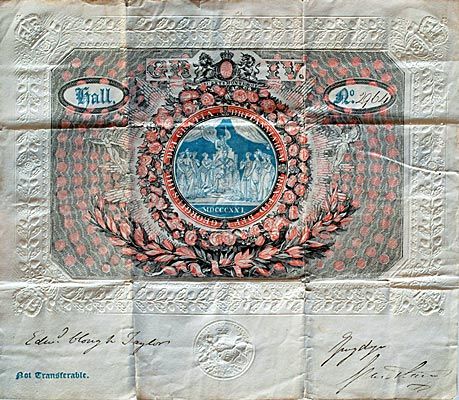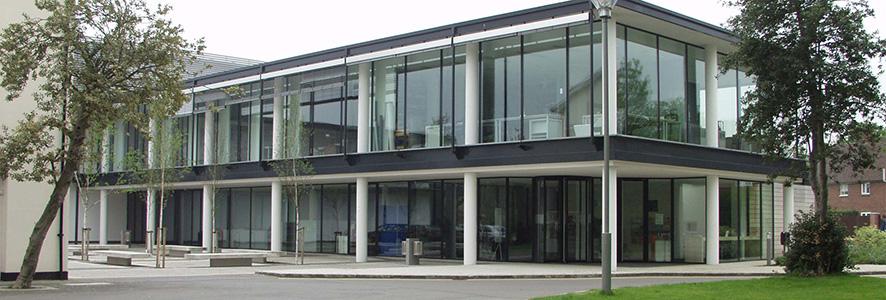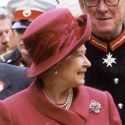
A Spontaneous Effusion of Love
During summer 2002, the Royal Berkshire Archive staged an exhibition to mark the celebration of the Queen's Golden Jubilee. Click on the links to see more about the Royal County's celebrations of royal coronations and jubilees, and also to see the documents on display.
Downloads:
PDF Souvenir poster of the Golden Jubilee exhibition
George III’s Golden Jubilee was a ‘spontaneous effusion of love’ according to one of its chroniclers. There was a national day of celebration on 25 October 1809. Yes, 1809 - the celebrations then were for the commencement of George III’s 50th year on the throne rather than it being 50 years since he had become King.
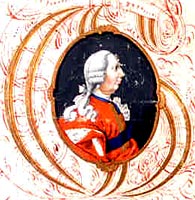
Portrait initial of George III from letters patent elavating the Earl of Hillsborough to the mark of Marquess of Downshire, 1789. (D/ED/F128)
Everywhere town and village folk feasted on roast ox, plum puddings and strong beer. Sermons were preached, God Save the King sung heartily and food and alms distributed to the poor.
In Reading they set free Danish prisoners of war; in Abingdon they threw cakes from the top of the Market House; in Easthampstead they had fireworks; at Hungerford there was a display of swordsmanship from the cavalry and in Wokingham muskets were fired in the Market Place.
The King and Queen were in Windsor where the Queen attended the ox-roasting in Bachelor’s Acre. A giant decorative arch had been constructed over the road by the Guildhall and the royal party passed underneath it as they went into the town.
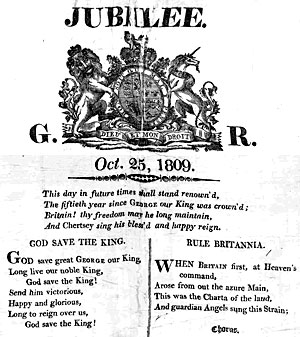
Verses on the Jubilee
As for the previous Jubilee, 1887 saw plenty of roast ox and plum pudding consumed, beer drunk and bonfires lit.
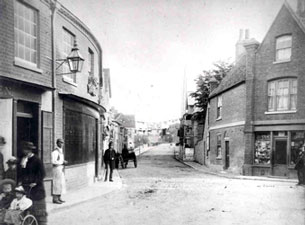
Decorations in Bridge Street, Caversham for the 1887 Jubilee (D/EX965/6)
The county’s best party was in Windsor, where the Queen arrived on Jubilee Day 22 June. She alighted at Slough Station and was driven through Slough and Eton before arriving at the Castle. The Castle and the town were illuminated and lunch was provided by the Queen for 6000 children. There was a torchlight procession through Home Park that culminated in the Queen knighting the town’s Mayor.
There were permanent monuments too. St Nicolas’s church in Newbury had a new stained glass window designed, Reading had a statue of the Queen commissioned to stand in front of the Town Hall and also built a water fountain in St Mary’s Butts. Windsor too had a statue placed in Castle Hill, with a time capsule in its pedestal, which contained an example of every coin of the realm.
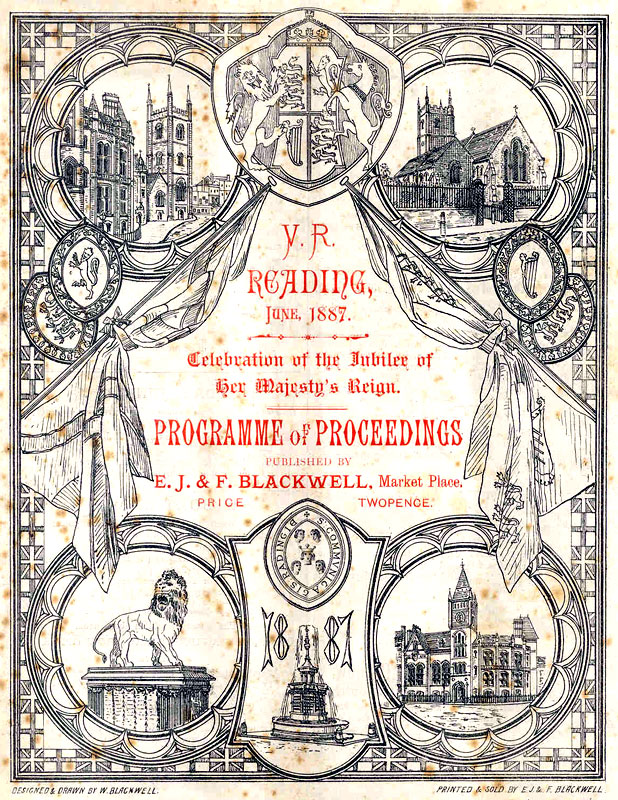
Programme for Reading’s celebrations of the 1887 Jubilee (D/EX1248/2)
Victoria’s Diamond Jubilee in 1897 was celebrated in a similar way. All the towns and villages in the county held street parties for their inhabitants – Reading even had a week of celebrations. A local businessman gave Maidenhead its clock tower and Windsor built a new ward for its Infirmary, while in Reading the Queen Victoria Nursing Institute was inaugurated.
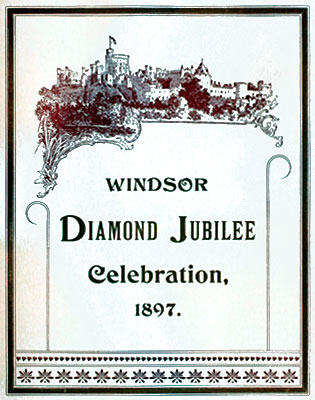
Programme for Windsor’s celebration of the 1897 Jubilee (WI/D15/3)
The first ‘colour’ coronation was celebrated in Berkshire with a mixture of the old and the new.
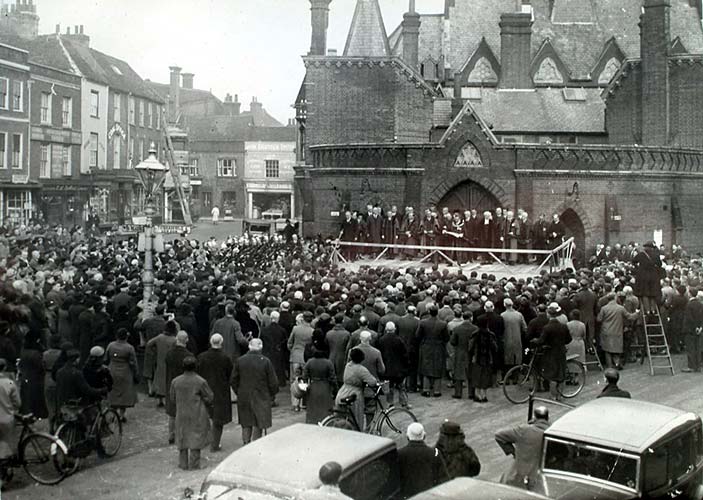
Proclamation of Queen Elizabeth at Wokingham Town Hall (WO/acc4266.5)
Slough’s celebrations were typical of many towns. A TV set was purchased so that the ‘old folk’ could see the coronation in one of the local church halls; 7000 coronation mugs were purchased to present to local schoolchildren, and a large portrait of the Queen was displayed on the central balcony of the Town Hall, illuminated by floodlights and surrounded by flowers. A Punch and Judy show was provided on coronation day at the Salt Hill Playing Fields, which was followed by the local Territorial Army unit parading around the town. Numerous street parties were held.
Coronation day, 2 June 1953, was a cold day with a strong north wind. At night there was heavy rain. But it didn’t stop the celebrations carrying on till late at night. In Reading there were fireworks and a giant bonfire at Hills Meadows.
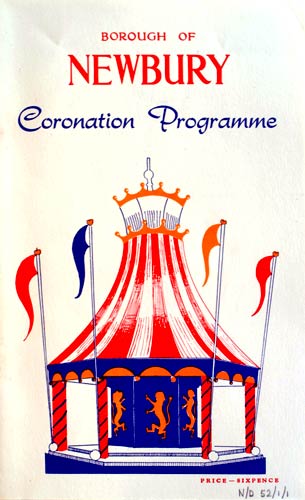
Newbury Borough Coronation Programme (N/D52/1/1)
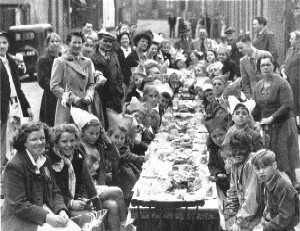
Stanley Street Coronation party, Reading (reproduced by permission of Reading Evening Post)
Berkshire is unique amongst English counties in being a Royal County. The title dates from 1958 when it was granted by the Queen in recognition of Berkshire’s strong royal links. The royal link is maintained not just through the title but also through the county’s two crown officers, the High Sheriff and the Lord-Lieutenant.
The High Sheriff’s role is Saxon in origin. Historically the ‘shire-reeve’ was the monarch’s agent for taxation and law and order in the county. The High Sheriff is still nominally responsible for ensuring that writs of the High Court are enforced in the county and for receiving judges visiting the county, although in practice much of this work is carried out by the Undersheriff.
Since medieval times the High Sheriff has been an annual appointment, and the tradition is that it cannot be refused if offered. The High Sheriff at the time of the Golden Jubilee was Timothy Dawson, and the Undersheriff was Nicholas Blandy.
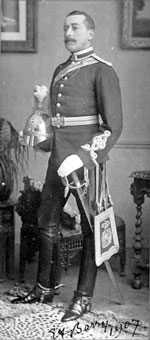
Sir Edward Barry of Ockwells Manor, Bray, High Sheriff in 1907 (Q/Z1/29)
The first Lord-Lieutenants were appointed to counties in 1545 for the purpose of organising the local militia to defend the realm against invasion or rebellion.
Today the Lord-Lieutenant is the Queen’s personal representative in the county for civic matters, and attends royal events in the county. He is also the Custos Rotulorum – the keeper of the county justices’ records. As such he maintains an important link with the county’s archives and Royal Berkshire Archive. The Lord-Lieutenant at the time of the Golden Jubilee was Sir Philip Wroughton.
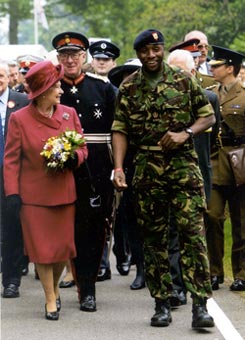
Sir Phillip Wroughton walking behind Her Majesty the Queen at Bisham Abbey, May 2002.
